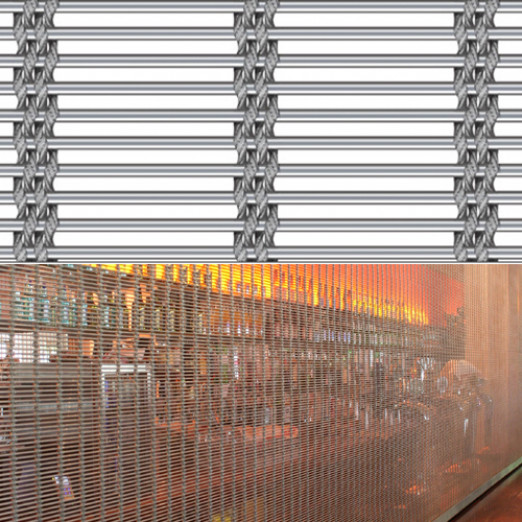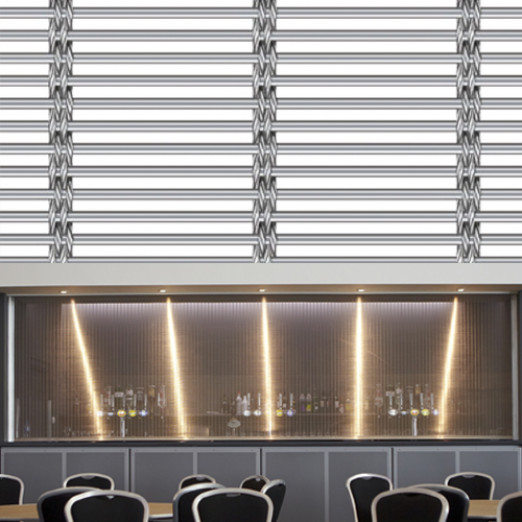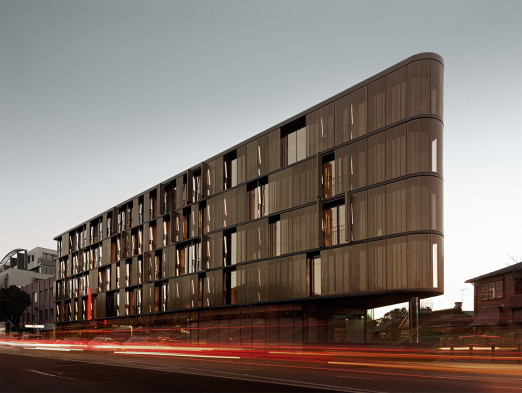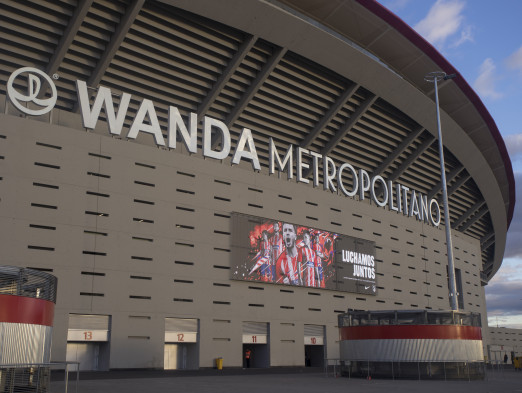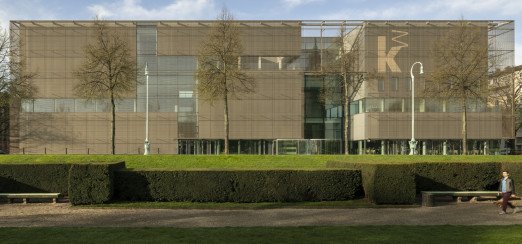"A quality hallmark for everyone involved in construction projects."
With the first general building approval (abZ) for metal fabric, leading international technical weavers GKD – Gebr. Kufferath AG (GKD) is once again setting standards. From now on, the company's metal fabric façades, ceilings, and fall guards no longer require case-by-case approval (ZiE). Three of the most popular fabric types – the spiral mesh ESCALE, as well as the two cable meshes TIGRIS and OMEGA – are now classed as regulated products with the accompanying mounting fixtures and can therefore be used throughout Germany in line with state building codes. Set against the background of the enormous time and cost input required to receive general building approval (abZ), GKD invited high level expert representatives to discuss the work associated with this approval, its significance, and its future role.
External assessors and the German Institute for Structural Engineering (DIBt) spent two years subjecting all components of GKD's metal fabric systems for façades, suspended ceilings, and vertical fall guard protection to strict experimental tests. The testing resulted in binding values for planners, auditors, and processors. In this vein, Volker Weuthen, architect and shareholder in HPP Architekten, Felix Späh, test engineer for construction engineering with his own engineering office, René Chaineux, an attorney specializing in industrial, construction and tenancy law, Professor Markus Feldmann, Head of the Institute for Steel Construction at RWTH Aachen University and Director of Steel and Lightweight Construction, Dr. Christoph Heinemeyer, engineer from the same department, Dr. Stephan Kufferath, 2 GKD Director, as well as Hans-Michael Link, Head of Metal Fabrics at GKD all came together to discuss what concrete role general building approval (abZ) of this kind will play for them in their day-to-day operations.
Stephan Kufferath opened the discussion by stating that GKD was the first company to use metal fabric in the field of architecture back in the early 1990s. In the same pioneering role, the company has now initiated this cost and time-intensive process with two objectives. He continues: "Thanks to their dimensions, measuring eight meters in width and 100 meters in length, GKD fabrics offer unique design options in the field of architecture. However, use of previously unregulated metal fabric often required approval on a case by-case basis". His company, therefore, identified the need to make GKD products more secure and customer-friendly. The status as a product with approval from the construction authorities also provides a clear differentiation from other providers and imitation products. From the perspective of attorney René Chaineux, this was both a correct and important step. Although planning and design are clearly important, the selected construction material in particular plays a crucial part in terms of the effects and functionality of a building. Case-by-case approval (ZiE) always requires investment of significant time and money, so working with construction materials that have general building approval (abZ) means that the architect has one important thing less to worry about. "Regulated products can really only be welcomed," adds architect Volker Weuthen in agreement, and also substantiates this opinion with the low staffing level at the construction authorities: "Many people no longer see the sense in jumping through all the hoops involved in using an unregulated product. It severely limits the number of people willing to go to the trouble of using such products." Test engineer Felix Späh also saw another fundamental problem with case-by-case approvals: "No case by-case approval (ZiE) can possibly cover absolutely every eventuality, so the contractor always has a residual risk." General building approval (abZ), 3 on the other hand, covers all technical questions, as it confirms that the product has been tested intensively over a long period by numerous experts. Executing firms are then capable of implementing everything correctly with regard to security, durability, and sustainability.
An impressive reputation that extends across Europe
Professor Feldmann believes that general building approval (abZ) is a genuine hallmark of quality, and experience has shown that it is also recognized in many countries throughout Europe. A company with strong international operations such as GKD, therefore, has a special mark of quality that facilitates significantly easier project implementation in other countries. Despite different framework conditions, planners and inspectors can always rely on general building approval (abZ) as a tailor-made standard for the product. This also justifies all of the time and effort that went into securing this status. Felix Späh added that without a basis of this kind many points would simply be decided by lower construction supervision authorities, and thereby indirectly by the test engineer – with corresponding uncertainties. The risk here is that everyone sees this slightly differently, particularly in the field of interior construction which is not strictly regulated. However, case-bycase approval (ZiE) is somehow always dependent on the person doing the inspection, even in the fundamentally regulated façade sector. Added to this is the fact that each federal state in Germany handles approvals slightly differently. His advice: "With general construction approval, you know what needs to be done." Architect Volker Weuthen is keen to stress that this aspect is indispensable, particularly with regard to BIM, digitalization in the construction sector: "Everybody wants clearly defined constructions."
Moving away from the gray zone thanks to general building approval (abZ)
Christoph Heinemeyer, who just like Professor Feldmann is often involved in general construction approvals as an assessor, believes that this also applies to metal fabricators. Theoretically, steel construction processes are regulated by the triad of standards: introduced standards or technical rules for the material being used, technical rules for its assessment (including questions of load and calculation theories for the safety certifications), as well as standards of the manufacturers and those governing installation. However, no such rules as to how a product is to be installed exist for unregulated products. For the processor, general building approval (abZ) therefore not only offers planning and manufacturing security, but also legal security in case questions regarding various quality issues come up at a later date. GKD Director Stephan Kufferath believes that his objective of dragging this topic out of the gray zone and providing greater security for everyone involved in the project through unique stipulations has therefore been vindicated. This is why GKD also selected the ESCALE, TIGRIS and OMEGA fabrics. Thanks to its special three-dimensionality, the ESCALE spiral mesh has been one of the most popular product ranges in the last few years. This is because it embodies textile materiality, particularly with extremely large façades. The other two fabrics are bestsellers from the range of cable meshes. As a classic for car park façades, TIGRIS provides an extremely important showcase, while OMEGA is a certified fabric that is regularly used for both outdoor and interior applications. With this fabric, GKD has therefore also addressed the topic of standard-compliant metal fabric for interior applications, such as ceilings and vertical fall guard protection. Division Manager Hans-Michael Link added that all three stainless steel fabrics also cover the greatest scope for interior applications thanks to their solar protection properties and certified standard compliance.
Benchmark for GKD metal fabric
Felix Späh is convinced that users have also benefited from the general building approval (abZ) now in place when using other fabrics from the GKD portfolio. This is because the general approval definitely also increases the speed of attaining approval in individual cases – insofar as this is even still required. Where the technical boundary conditions for a similar fabric are clear, GKD can potentially also provide planners with a technical supplementary sheet on the general building approval (abZ) or have the existing approval extended accordingly by the German Institute for Structural Engineering (DIBt). "With the tests shown here, GKD has set a benchmark for its metal fabrics," stresses Professor Feldmann. The general building approval (abZ) therefore represents a basis which can also be used to weight deviations accordingly in future.
CE mark alone not sufficient
Felix Späh also saw the general building approval (abZ) as a benchmark for GKD fabrics. "As structural engineers, we are happy when we can have something regulated like this, as it then allows us to reject anything unregulated." Volker Weuthen confirmed: "Anyone can supply bricks and concrete. However, the architectural contract for a special product like metal fabric, which can only be supplied by someone with abZ general construction approval, will in future state 'metal fabrics that have a product description for metal'." He added: "Public invitations to tender in Baden-Württemberg include the note that all products used also require either CE approval, general building approval (abZ) or case-by-case approval (ZiE)." For Felix Späh, general building approval (abZ) plays an important part, particularly in the context of the German Construction Products Regulation (BauPVO) and CE. "As per the new jurisdiction, products bearing the CE mark may be put into circulation in Europe. However, the CE mark only certifies one property, 6, for example, the load capacity of a brick. Yet as an exterior component for façades, it also needs to be frost-resistant. The CE mark does not provide any information on this in our example." This repeatedly leads to significant problems, particularly in the case of small and mid-sized construction projects. A metal fabric façade could simply be installed without anyone having asked whether it is even permissible based on construction law. Clarifying issues like this can take a lot of time and requires case-by-case approval. In some cases, the façade may even have to be taken down again. It is easy to imagine the kind of stress and frustration this would cause for those managing the construction project. Volker Weuthen is also happy to confirm this, as HPP obviously not only works on major projects. If €4,000 is suddenly required for case-by-case approval (ZiE) in a small project, this will surely annoy the construction manager responsible. All participants, therefore, agree that general building approval (abZ) therefore not only offers significant relief for planners, inspectors, and processors, but also key added value for contractors - particularly for small and mid-sized construction projects, which represent the majority of all projects. On the construction site, architects, engineers, and construction supervisors would have to decide whether the product can be used or not. A CE mark is also not automatically sufficient here. General building approval (abZ), on the other hand, covers everything and consequently represents a secure basis for deciding whether the product can fulfill its purpose in the long term.
Handling and legal security thanks to general building approval (abZ)
Taking a different perspective, it also grants architects sufficient design freedom. "General building approval draws a border around the fabric," explains Christoph Heinemeyer. "The only calculations required for fabrics concern the screws." It is the definition of this interface to the facilites that is 7 particularly important. For example, attachment of the TIGRIS fabric with eyebolts is always the same. The width determines the spacing between the eyebolts. The load for the screw is calculated on the basis of the length of the fabric used. The architect then has the necessary calculation parameters and, at the same time, a great deal of flexibility for the implementation. Felix Späh believes that the sum of benefits for everyone involved therefore also justifies the time and effort required by manufacturers to receive general building approval (abZ). This requires the architect, test engineer, structural engineer, and metal fabricator to assume responsibility for ensuring that the product used will work correctly in the long term. Being able to offer products with general building approval (abZ) therefore represents a huge economic advantage. Once certified, such approval covers everything and not only applies in individual cases. The external quality control secured with general building approval (abZ) also guarantees that manufacturing processes and products permanently deliver what was certified in the general building approval (abZ).
Assistance in removing application hurdles
Stephan Kufferath was happy to state that the general building approval (abZ) acquired for GKD metal fabrics also represents an important contribution to acceptance of the construction material as a substantial component in modern architecture. After all, with this general building approval (abZ), GKD is now providing architects, planners, and processors with assistance in handling metal fabric as a way of removing any fears of stress or application hurdles. From the perspective of attorney René Chaineux, this is a key fact, as general building approval (abZ) is an important instrument - not only for the construction supervisory authorities - to ensure that a construction material is secure and nobody can get injured by it. In the planning phase and when preparing to award contracts, 8 architects can work with an approved metal fabric product produced by a manufacturer that has been established in the market for decades with generally recognized technology. This also help planners remain on the safe side, as they can copy the requirements from the general building approval (abZ) over to the private law invitation to tender. In summary, Professor Feldmann stated that products approved by the construction supervisory authorities provide a basis for architects to specify their invitations to tender accordingly, for structural and test engineers to receive certified design and performance figures, as well as for metal fabricators to receive reliable handling instructions. Manufacturers like GKD who possess general building approval (abZ) then enjoy an internationally recognized quality hallmark that brings benefits to everyone involved in the construction project.
GKD – WORLD WIDE WEAVE
As a privately owned technical weaver, GKD - Gebr. Kufferath AG is the world market leader in metal, synthetic and spiral mesh solutions. Four independent business divisions bundle their expertise under one roof: Industrial Mesh (woven metal mesh and filter solutions), Process Belts (belts made of mesh and spirals), Architectural meshes (façades, safety and interior design made of metal fabrics) and Mediamesh® (Transparent media façades). With its headquarter in Germany and five other facilities in the US, South Africa, China, India and Chile – as well as its branches in France, 9 Spain, Dubai and worldwide representatives, GKD is close to markets anywhere in the world.

